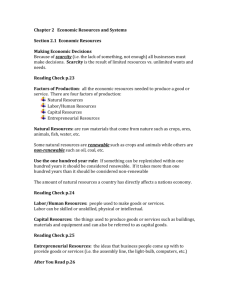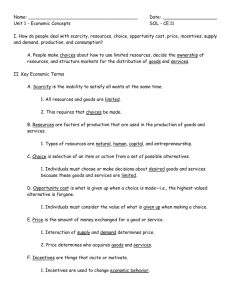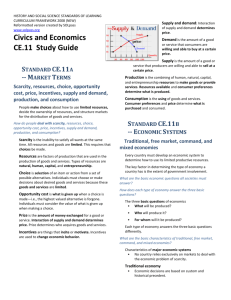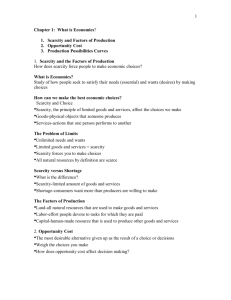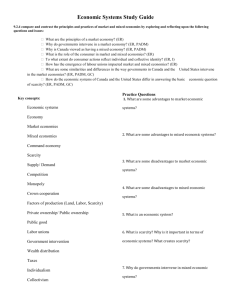Ch. 2 Notes
advertisement
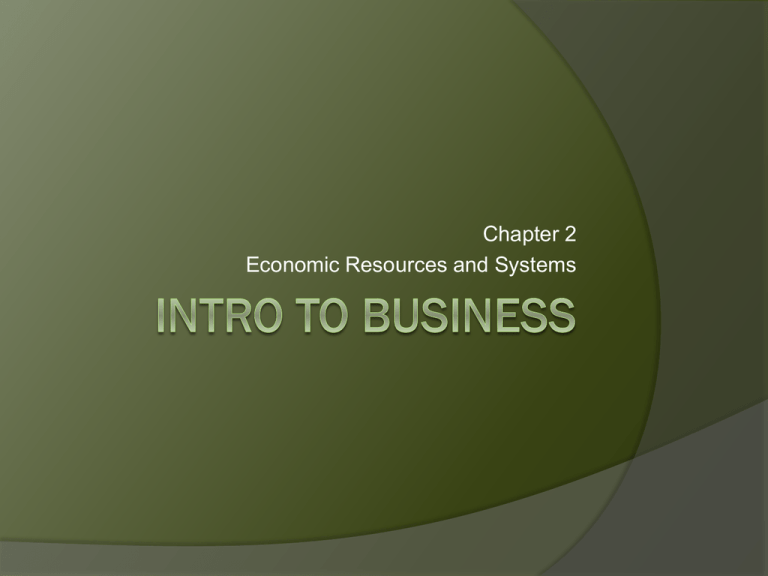
Chapter 2 Economic Resources and Systems Economic Resources Making Economic Decisions Scarcity – The inability to satisfy all of everybody’s wants . Individuals, businesses, and countries face a lack of resources Principle of Scarcity – there are limited resources for satisfying unlimited wants and needs. Factors of Production All economic resources necessary to produce a society’s goods and services 2-1 Economic Resources Factors of Production 1. Natural Resources ○ Raw Materials from nature that are used to produce goods 2. Trees, water, grains, cattle, coal Renewable Resources- can be reproduced Wheat and cattle Non Renewable Resources- Limited Ex. Coal, iron, oil Labor Resources ○ ○ People who make the goods and services for which they are paid. Labor can be skilled or unskilled, physical or intellectual. Economic Resources 3. Capital Resources Things used to produce goods and services (Capital Goods) ○ 4. Tractor, Delivery Truck, Computers, Medical Supplies Entrepreneurial Resources Individuals who start and direct businesses to produce goods and services to satisfy needs and wants Used by people who recognize opportunities and start businesses Entrepreneur – An individual who undertakes the creation, organization, and ownership of a business ○ Entrepreneurship- The process of recognizing a business opportunity, testing the market and gathering the resources necessary to start and run a business. Questions Why do all nations face the problem of scarcity? 2. Identify one similarity and one difference between labor and entrepreneurial resources? 3. Describe the four factors of production 1. Economic Systems Economics – The study of how individuals and groups of people strive to satisfy their needs and wants by making choices Basic Economic Questions What should be produced? ○ Deciding to use a resource for one purpose means giving up the opportunity to use it for something else. ○ This is the opportunity cost. How should it be produced? ○ Methods and labor used as well as the quality of the items produced. Who should share in what is produced? ○ In most societies people can have as many goods and services as they can afford to buy ○ The amount of income they receive determines how many goods and services they can have. 2-2 Different Types of Economies Economic System The methods societies use to distribute resources. Command Economy Economic system in which a central authority makes the key economic decisions The government dictates what will be produced, how it will be produced, and who will get the goods. Higher skilled workers earn the same as low-skilled workers Socialism – Moderate Command Economy ○ The state owns the major Resources Mixed Economy An economy that contains both private and public enterprises Combines elements of both capitalism and socialism. Different Types of Economies Market Economy Economic system where economic decisions are made in the marketplace. ○ Marketplace – Where buyers and sellers meet to exchange goods and services . Also called Private enterprise system, free enterprise system, or capitalism. Different Types of Economies Market Economy continued: Relationship between Price, Supply and Demand ○ ○ ○ ○ Price – Amount of money given or asked for when goods and services are bought and sold Supply – Amount of goods and services that producers provide at a various price Demand – Amount or quantity of goods and services that consumers are willing to buy at various prices The higher the price, the less consumers will buy. The lower the price, the more the consumers will buy. Equilibrium Price – Is the point at which the quantity demanded and the quantity supplied meet. At any other price you would either have a surplus or shortage Typical Demand/Supply Curve Demand and the Price Effect Price Elasticity of Demand- is a measurement of the impact of the price effect. It indicates a buyer’s eagerness to buy a good or service. • Elastic vs. Inelastic Demand P r i c e D1 Quantity D2 Demand and the Price Effect Factors that Affect the Elasticity of Demand: - Availability of Substitutes - Percentage of Budget - Time Elastic Demand Inelastic Demand Many Substitutes Few Substitutes Expensive(require High % of Budget) Inexpensive Time to Plan or Adjust Must Buy Now Questions 1. 2. 3. How does a market system decide what will be produced? In a market system, what determines how many goods and services an individual can buy? Some nations can produce more goods with fewer workers than other countries that have more workers. How can that be true?




